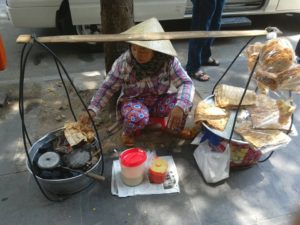Sweet and Sour

When the father has eaten too much salt in his lifetime,
then his son thereafter will have a great thirst
– Vietnamese Proverb
Before we went to Vietnam I had only ever seen depictions of the country in films about war; Apocalypse Now (1979), Good Morning Vietnam (1987) and Born on the Fourth of July (1989).
When we reached our destination, there were still reminders of a horrible and not too distant history. Nearby were the Củ Chi tunnels, an immense network of connecting underground passageways.
During the Tết Offensive in 1968, this was the location of several military campaigns, used by Viet Cong soldiers as hiding spots during combat.
We didn’t go. I am far too claustrophobic by nature and Botticelli in size to go down into into those narrow burrows.
But an American traveller and friend shared her experience. She told me how she reversed into the tunnel, how you slide in and hold the lid above your head (all disguised above ground as grass).

image © Marla Berarducci
The tunnels have been widened since the war for tourists, but my petit pal still had to stay in a line, with only just enough space to move.
It sounded horrific.
But Vietnam has of course moved on from its past and is forging ahead. All around Ho Chi Minh City there were signs of advancement and rapidly improving infrastructure.
On our recent trip, we spent many hours lazing by the Saigon River.
Clumps of reeds were washed up river when the sea was at high tide. The same clumps would pass by later, being pulled back to the estuary at low tide; doing a gentle waltz up and down the Saigon river.
We embraced the chance to slow down and we would watch it all flow past. And by day we enjoyed the gentle flow of conversation, while sitting and viewing fishermen in their small traditional boats.
Most days they would wave or smile to us as they passed by. I observed, as the men went on with their fishing using traditional methods, beating the surface of the water with an oar and seeking out their catch in much the same way that generations before them had done.

They were in no rush. They were taking it slowly.
By contrast, immense barge-like vessels would rush by, delivering sand, cement and building materials up river. Those materials are being used to construct new neighbourhoods; executive apartments with Saigon river views. Progress.
Each time the boat would pass us submerged by its weight. The crew would make its delivery. The boat would return empty, floating high above the surface. Buoyant.
It was almost as if the boat was smugly proclaiming “I’ve done my bit. Ho Chi Minh can grow now”. Proud as punch.
Old transport. New build.
And while we witnessed all this activity on the Saigon River, we got to sample the many flavours of Vietnamese food, such as Gỏi cuốn / spring rolls, Phở / noodle soup and Bánh bột chiên / rice flour cake omelet.
From the late 1880s until 1954, Vietnam was part of French Indochina. Like so many places, food is steeped in the country’s history and affords some view into the culture. Vietnamese food has many influences from French cuisine, like the bánh mì (filled baguette). And, of course, we consumed a few too many fresh, flaky croissants.
Rice is a staple for Vietnamese people and it can be seen growing locally in rice padi fields. But noodles, invented in China around the time of the East Han Dynasty, also found their way onto Vietnamese tables.
During our trip, many dishes could be Vegetarian friendly, as most featured an assortment of vegetables and could be prepared without fish sauce. Some foods, like the spring rolls and the lettuce rolls were wrapped neatly; tiny, petit parcels of food.
A great emphasis seemed to be placed on freshness. People use local, seasonal ingredients and prepare food healthily; grilled, boiled or steamed. Overall, the food was much less oily than many other cuisines across S.E Asia.
Vietnamese food seems to achieve a very particular equilibrium; a kind of yin and yang on the palate. And if you had to try to sum up this cuisine, I would suggest that it’s the balancing act between sweet and sour which stands out.
And perhaps sweet and sour is a good likeness for the place too; a sweetness that fuses alongside a sour and spicy kick. The people who we met were sweet; polite, smiling and graceful. Along with this is the sourness of the nation’s history, a myriad of noisy mopeds and the construction cranes of growth.
So, how much can a type of cuisine or a dish be representative of a nation?
I’m reminded here of Ben Zephaniah’s poem, The British. The Vietnamese people get a mention there too. The poem is a brilliant, celebratory analogy for the melting pot of modern England. I wish for ‘some unity, understanding, and respect for the future’, though in post Brexit Britain, that is rapidly changing. For now at least, Chicken Tikka Masala and Thai Green Curry are widely seen as the most popular dishes enjoyed across the country, reflecting the fusion of cultural flavours in a modern, cosmopolitan society.
In South Africa there is the mighty braai. Could it be seen as representative of the nation? It’s definitely a national pastime and worthy of another, more detailed blog post.
Think of a place you have been where different flavours have come together. How much can a type of cuisine or a dish be representative of a nation?

image © Marla Berarducci
© Maggie Miranda/Mother City Time